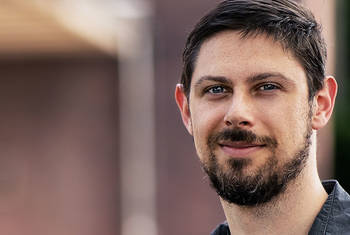Though we are familiar with the phenomenon whereby a sudden drop in temperature precedes a thunderstorm, scientific understanding of these “cold pools” has been limited. In this video, FELIX AMENT analyzes the extensive insights that the FESSTVaL (Field Experiment on Sub-mesoscale Spatio-temporal Variability in Lindenberg) campaigns have provided into cold pools. Forming a broad observation network which involved [...] Watch video
The microscope is an essential tool in many areas of scientific research. In this video, ULRIKE FUCHS explains how the latest developments in laser technology can significantly improve microscopy. Focusing on fluorescence microscopy, Fuchs demonstrates the advantages of using a laser with a “top hat” shaped beam distribution in place of the standard Gaussian beam distribution. Delivering striking improvements in areas [...] Watch video
Every galaxy seems to have a supermassive black hole in its center. A black hole is defined as such because nothing can escape from a certain point inside, not even light. There is, however, a last stable orbit which is called the event horizon outside of which gas can still radiate away. This event horizon might be the key to understanding black holes and, therefore, observers are interested in resolving the event [...] Watch video
The quantum spin Hall effect was first proposed by Kane and Mele in 2005. In this video, LAURENS MOLENKAMP outlines how his team’s focus on mercury telluride has provided notable insights into this phenomenon. Conducting transport experiments on special semiconductors grown using a molecular beam epitaxy machine, Molenkamp’s findings include the identification of the quantum Hall effect in a three-dimensional [...] Watch video
The silicon-based technology that is used today to access and compute information is reaching its limits. To further improve computing capacity, this essentially two-dimensional technology, as STUART PARKIN puts it, needs to give way to the three-dimensional approach of spintronic devices that use not only electric current but also the spin of the electrons. In this video, he explains how the research team created a new [...] Watch video
THOMAS PFEIFER is interested in the origins of motion: how, on an atomic level, motion is coming into play and how this motion that is initially described by the laws of quantum mechanics then transfers into the classical motion we can see. For this, researchers employ a combination of spectroscopy and laser methods. The specific research question presented in this video investigates how a very fundamental system, such as [...] Watch video
What are the building blocks of our universe that everything is made of? In this video, ASTRID EICHHORN explains how her work seeks to reveal the fundamental microscopic structure of space-time. While recent pioneering experiments have confirmed aspects of Einstein’s General Theory of Relativity, this work seeks to overcome the limitations of current observational technology through theoretical investigations of the [...] Watch video
How Can the Statistical Properties of Cosmic Structures Be Calculated with Simple Physical Laws?
So far, the understanding we have of cosmic structures comes from numerical simulations. As MATTHIAS BARTELMANN explains in this video, his research group has developed a different method to calculate the statistical properties of cosmic structures in order to better understand why they evolve in the way they do. The researchers employed concepts of statistical field theory and could therefore use much simpler dynamical [...] Watch video
The theory of materials science investigates the electronic and structural properties of advanced materials, nano-structures and bio-molecules. In the study explained in this video, the researchers present a novel theoretical method to describe, design and control how molecules and materials in combination with photons may lead to new states of matter with novel emerging properties. The research aims to theoretically find [...] Watch video
Understanding the behavior of liquids in porous materials is important for very different areas of our lives, ranging from the recovery of oil from rock to water holding capacities of different soils. The study presented in this video is dedicated to the quest for the mechanisms behind these processes. STEPHAN HERMINGHAUS explains that, starting out, the researchers had several ideas for what the general principle might [...] Watch video
Theoretical models suggest that a large part of our universe is made up of dark matter - this has not yet been directly observed but the existence of dark matter is inferred from its gravitational effects such as the rotation of galaxies. Currently researchers work on directly detecting these particles instead of just predicting them theoretically. In this video MANFRED LINDNER describes the detector used by the team of [...] Watch video
What makes exoplanets habitable? BARBARA ERCOLANO pursues this overarching question by focusing on the birth sites of these planets. Planets are born in the circumstellar disk that surrounds every young star. The specific research question presented in this video centers on the star TW Hydrae, which is very close to earth. The researchers investigated whether the T Tauri star “TW Hydrae” has a protoplanetary disk that [...] Watch video
For more than one hundred years, scientists have been working to uncover how turbulent flows occur. This would enable them among other things to predict how pollutants spread in water or how pollen travel in air. As EBERHARD BODENSCHATZ explains in this video, new insights are offered by an approach based on Lagrangian Particle Tracking Technique: The researchers focused on a single particle in a fluid and followed it [...] Watch video
Galaxies are filled with particles traveling very close to the speed of light; these are so-called ultra-relativistic particles. Until recently, it was very difficult to investigate these particles because of a lack of good observational data and they have been rather neglected in the study of astrophysics. As JIM HINTON explains in this video, his research group is interested in understanding how these particles [...] Watch video
How Can Plasma and Proton Beams Be Used in Building Next Generation Particle Accelerators?
The greatest developments in particle physics have been achieved with the help of particle accelerators. To answer open questions on particles, even stronger accelerators are needed but conventional technology encounters limits. The new ‘plasma-wakefield acceleration’ technology is designed to build high performance accelerators that are more compact. As ALLEN CALDWELL explains, the basic idea is to generate a plasma [...] Watch video
Over decades, beliefs such as ’the magnetic fields of planets in our solar system are all the same’ or ’moons don’t have magnetic fields’ were widely held. Using the example of Ganymede, Jupiter’s biggest moon, both premises were proven wrong. ULRICH R. CHRISTENSEN examines the theory of the so-called iron snow regime as the cause of magnetism: This theory assumes that iron crystallizing at the top of [...] Watch video
The dust in our Milky Way is the constituent of the cosmic life cycle. It is the substance from which new stars are generated and it is what stars become once they die. Unfortunately, as HANS-WALTER RIX explains in this video, the dust turns distance measurements of stars in the Milky Way into a difficult endeavor, because it dims objects and blocks light from the material behind it. In his project two common methods of [...] Watch video
Can the Perovskite Semiconductor Provide Sufficient Sustainable Energy in the Near Future?
One hour of sunlight is enough to power the entire planet for over a year. MICHAEL SALIBA is a leading scientist who investigates how we can tap into this abundant energy source in order to produce sustainable electricity in the future. As he explains in this video, the perovskite semiconductor – a new material that was discovered about five years ago – has great potential to advance the use of solar energy. The [...] Watch video
Over the last two decades the discovery of planets outside our solar systems has enabled researchers to study how planetary systems form - the major question within the field of astronomy today. These planetary systems and the respective planets vary significantly from each other. In order to understand how these differences come about, the research presented in this video goes back to the birth sites of planets and [...] Watch video
The objectives of the research in theoretical physics presented in this video are to understand the fundamental physics behind the properties of black holes and to find out whether black holes are unique in their way of information-processing. As GIA DVALI explains, the research he developed together with CESAR GOMEZ has two important findings. Firstly it shows that quantum criticality is the basic principle of the [...] Watch video
Exoplanets are planets beyond our own solar system. Since they do not emit much light and moreover are very close to their parent stars they are difficult to detect directly. When searching for exoplanets, astronomers use telescopes to monitor the brightness of the parent star under investigation: Changes in brightness can point to a passing planet that obstructs part of the star’s surface. The recorded signal, however, [...] Watch video
Galaxies keep drifting apart from one another. This is because the universe is expanding in an accelerated way. It is mostly composed of matter and thus the acceleration should slow down because matter carries gravity and gravity is a force which pulls, but does not push, if one neglects the cosmological constant. This is not the case and it is currently assumed that this accelerated expansion is caused by dark energy. [...] Watch video
In electronic devices, material imperfections play a key role in determining lifespan as well as in safety considerations. In this video, CHRISTIAN LIEBSCHER puts such defects under the microscope so that we can better understand their atomic structure. Focusing on grain boundaries at which different crystals join together and using transmission electron microscopy, Liebscher explains how this research can bring about [...] Watch video
Electrochemical processes play a central role for sustainable energy conversion and storage technologies, such as water splitting, hydrogen fuel cells and batteries. In order to maximize the efficiency, stability and life expectancy of these devices, it is necessary to develop accurate simulation techniques to explore and predict structural properties and chemical reactions at electrified surfaces in contact with liquid [...] Watch video
On an atomic scale, the area of a material in which different crystalline structures come together is known as a grain boundary. In this video, LIAM HUBER investigates the behavior of alloying elements at grain boundaries. Identifying impracticalities in quantum mechanical simulation, Huber uses classical simulation to study how atoms behave at the grain boundary and how this influences the properties of that grain [...] Watch video
It has long been understood that hydrogen has a negative effect on metals like iron and steel. Studying this phenomenon is not easy because of the fact that hydrogen is everywhere, is extremely small and is in constant motion. In this video, MARÍA JAZMIN DUARTE CORREA explains how new technologies can help to pin down the impact of hydrogen in this context. Focusing on the particular challenges involved in studying [...] Watch video
Having played an acknowledged role in the 2011 Fukushima disaster, it has long been understood that hydrogen penetration can accelerate the deterioration of structural materials. In this video, BAPTISTE GAULT analyzes this process of hydrogen embrittlement and puts forward ideas as to how it can be combated. Focusing on steel in the first instance, Gault employs atom probe tomography to pin down the scale and location of [...] Watch video
One very promising way of producing energy in an environmentally friendly manner is via hydrogen fuel cells. In this video, ALBA GARZÓN MANJÓN explains that a fundamental barrier to the widespread adoption of this technology is the prohibitive cost of the noble metals that act as catalysts in the fuel cell. Garzón Manjón’s research seeks to identify alternatives, centering her search on high entropy alloy materials. [...] Watch video
Lasers typically produce a Gaussian beam where intensity is greatest in the center and tails off at the edges. In this video, ULRIKE FUCHS explains how a laser beam profile can be transformed into something more effective for material processing. Drawing on insights from phase shifting microscopy, Fuchs shows how a phase plate can be used to change the phase distribution of an incoming Gaussian beam before it is focused. [...] Watch video
Recent research has shown that solid materials can be classified based on their electronic band structure using the abstract mathematical concept of topology. In this video MARKUS MORGENSTERN explains how interdisciplinary research found the first material of a topological type called “weak topological insulators” and how this might solve problems in the field of quantum computation. Watch video
How Can We Experimentally Determine Why Hydrogen Atoms Are Absorbed on Metal Surfaces?
Although very light weight, hydrogen atoms have a high probability to be absorbed by a metal surface upon collision. In this video, OLIVER BÜNERMANN explains collision experiments carried out to determine why this is the case. During the experiment, they shot a hydrogen atom beam at a gold surface and at an insulator, measured the speed and direction of the atoms bouncing back from each surface and compared the results. [...] Watch video



































